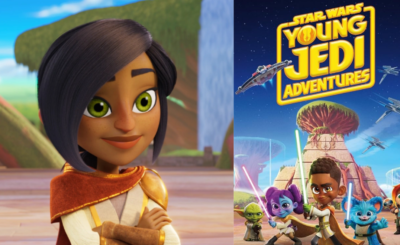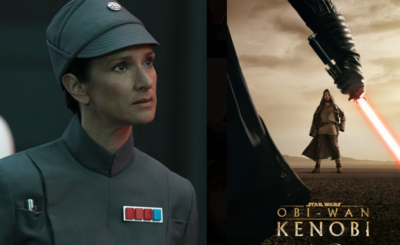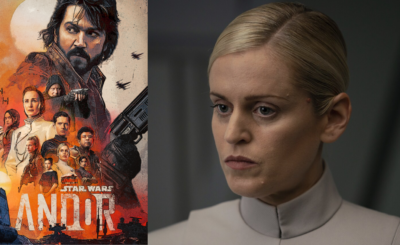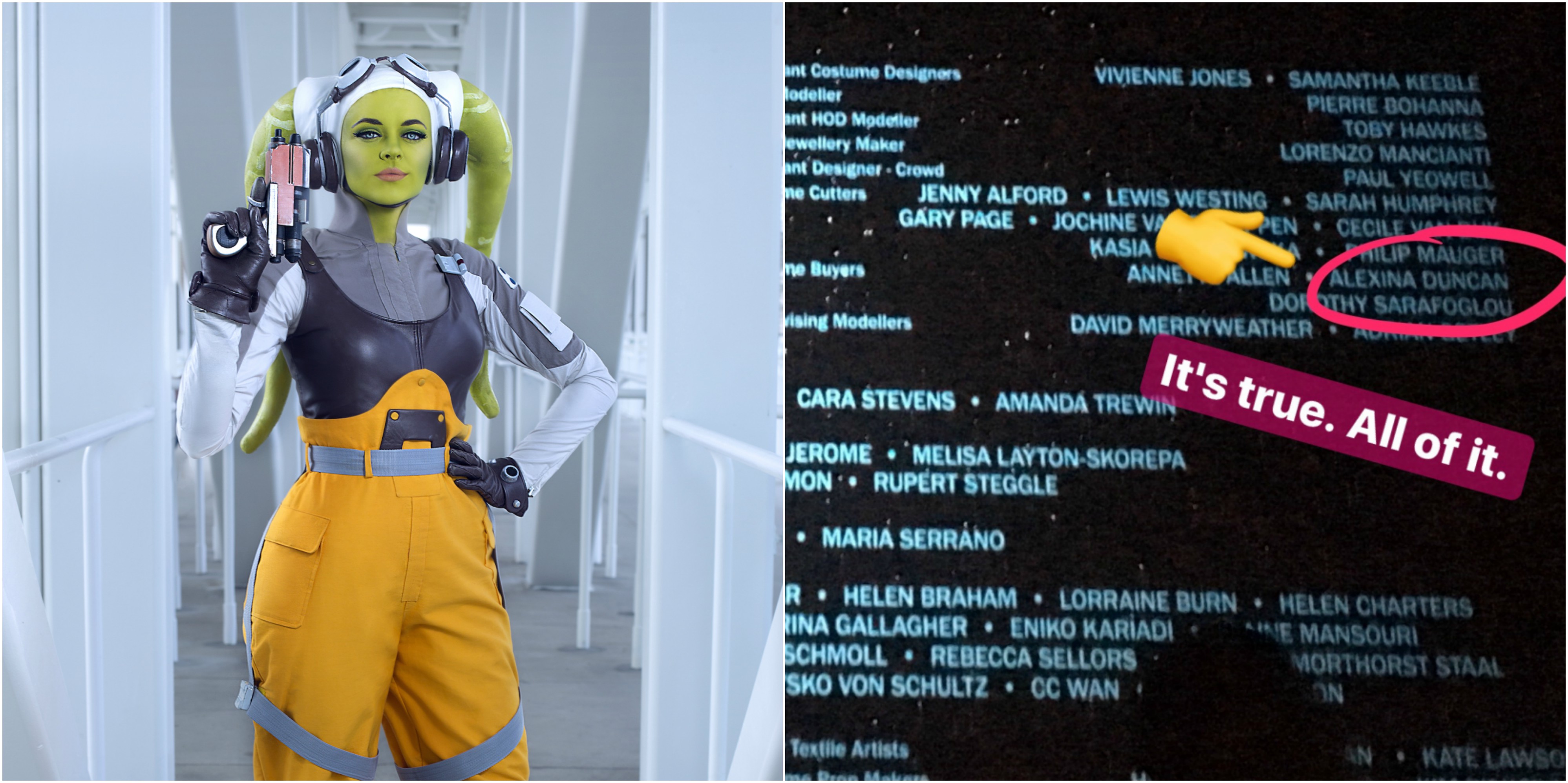
Alexina Duncan was a costume buyer for The Last Jedi. She also regularly cosplays as Hera Syndulla with the Rebel Legion. She was kind enough to answer a few questions via email for 365 Days of Star Wars Women.
How long have you been a Star Wars fan?
Literally for as long as I can remember! One of my first – if not the first – memories is explaining the Empire Strikes Back to my dad, so I really don’t remember a time before Star Wars.
What was the first costume based off a character you created and what inspired you to make this costume? If it wasn’t a Star Wars character, what was your first Star Wars character costume?
If we really get into it, the first character costume that I made myself from scratch was a wearable textile sculptural piece based on Madame de Merteuil from Les Liaisons Dangereueses. I think it’s a fact that every costume person has an eighteenth-century phase at some point and mine hit me right as I began pushing towards costume as something more than an unproductive passing interest. It was this vast wire structure mirroring panniers and stays, draped with dress patterns that I laminated, melted, embroidered with this sort of mass of fabrics, embroidery, and all sorts of weirdness drawing from anatomical drawings pouring out to reflect her rot both as a character, and her inner rot as she is slowly dying from syphilis. Cheerful stuff! I was really proud of that piece, but unfortunately I think I’ve lost all photos of it.
Cosplaywise, I guess Bellatrix Lestrange for the book launch of the Deathly Hallows. But as far as I was concerned it was just dressing up – I got ready in the bathroom after work – and it was a closet cosplay with different garments layered up and slashed. First cosplay – true cosplay – from scratch was a Rebels Ahsoka Tano for Star Wars Celebration Europe in 2016. It was a disaster as I did it in around 48 hours, and I mostly try to forget it ever happened! Making Hera Syndulla almost exactly a year ago was when I started taking cosplay seriously as something for myself.

Why did you decide to submit your Hera work to Rebel Legion?
Mostly just because, to be honest. Despite being something of a disaster, my Ahsoka caught the eye of someone in the Rebel Legion who tracked me down and hassled me to join. I ignored him but we became friends anyway, and when I kicked Hera off for Star Wars Celebration Orlando I decided, ‘why not?’ The way I work is compatible with the Legion’s standards and strive for accuracy, so I mostly thought it would be a nice feather in my cap. Make the costume, get cleared, do the minimal one-troop-a-year and that would be that. Unfortunately it escalated into so much more and kind of took over my life!
Can you tell me a bit about the Rebel Legion for people not familiar with this organization.
I honestly never expected to love the Rebel Legion like I do! I’m not much of a participator, but when I went on my first troop – which I intended to be my only troop – a little girl ran up to me and told me that she dressed up as me (Hera) and faced up to some bullies. That’s when I realised I was hooked. Those amazing, magical moments you share with children because their character has come to life and is right in front of them. It’s when your costume is elevated from being this thing that you made at home to something that has this great, wider meaning and weight and you get to share that with other fans.
The Rebel Legion is a Star Wars costume club – the good guys! – and we use our costumes for charity fundraising and community events, to connect and share our love of Star Wars and costumes with the general public in a real and meaningful way that can be so unbelievably moving. As we, and our sister organisations the 501st (the ‘bad guys’) and the Mando Mercs, do cosplay in an official capacity – and we are lucky to be recognised for our work and sometimes get to work directly with Disney and Lucasfilm – it means that there is an infrastructure and submission process just to make sure everyone is working at the same level. The aim is to be as close to screen accurate as possible, and the legion forum is an incredible community with a vast wealth of information!
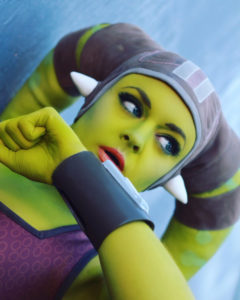
If looking to join, it is recommended that you start a progress thread on the forum showing your process as you make your costume, and other members can offer tips or advice, or just encouragement, to make sure that you are meeting the necessary standards and can have your costume cleared as smoothly as possible when it is done. Once you have finished your costume, take pictures from all angles and submit them to be checked against the character standards for accuracy. It can look very intimidating from an outside perspective, I know, and there can be this sense of elitism sometimes between those in the legions and cosplayers working outside, but honestly it is all cosplaying. The aim of all who cosplay is to celebrate their favourite characters in this amazing combination of costume and skill and performance participation. The only difference is that in the legion we are all working together within this structure; it’s just a different, more formalised way of doing things that is always striving to be as inclusive as possible so that we can do our best for communities and charities.
What is your favorite Star Wars cosplay and what are you working on now?
At this point my favourite cosplay is still my girl and my general, Hera Syndulla. She was my first serious cosplay (or at least I like to pretend she was), and I don’t see me retiring her anytime soon. She gets the most amazing response from people of all ages at all sorts of events. She is my favourite character in Star Wars and was literally the reason that I came back to the franchise and fandom after ten years – it always feels ridiculous to say that a fictional character changed your life, but she did. She has inspired me and pushed me, as well as being incredibly identifiable and relatable. I know that there are so many things, personally and professionally, that I wouldn’t have gone for if I hadn’t stumbled across Rebels and found her. Being able to share how much she means to me and celebrate her through my work is the most wonderful feeling. Also: it is an incredibly comfy costume to wear, even with the body paint.
Right now I am working on her Red Phoenix Squadron flightsuit. Life has, unfortunately, gotten in the way so it is unlikely that she will be ready for the show’s return after the hiatus. But she will definitely be ready to give the show the best possible farewell. Then I’ll be taking a brief foray into live action with Jyn Erso, which is nervewracking.
I’m curious what your favorite part of creating a costume is and what your least favorite part is.
Favourite part and least favourite…. It’s hard to say. I love the entire process of costume making. I always feel like my cosplay work, particularly given that I primarily do animated characters so there’s a level of interpretation at play, is like industry in microcosm. There’s the sampling and the sourcing, the toiling and fitting, then the actual making. Then that magical moment where it all suddenly rushes together and is done. There is a joy in every process, but also frustration. I love sourcing my fabrics and materials; I work as a costume buyer, so it gives me a chance to take my professional knowledge and practice but apply it to myself. For me costume was always this external thing that was done for others, to facilitate others, so cosplaying for me has become this sort of very self-indulgent, therapeutic action.
As I primarily make animated characters right now, the most stressful part is probably the process of breaking down the character model and working out how this unreal design can be made physical. Specifically: seams! Where can you cheat it? Where can you work around? Where are the fastenings on this impossible garment? Also: where are the character’s knees? You work out the knees and the waist, and you can calculate the rest from there. It’s the most crucial step to making sure that the costume works at all. But as frustrating as that process can be, with a lot of trial and error, when you nail the cut and the silhouette it is all worth it and it becomes the best feeling.
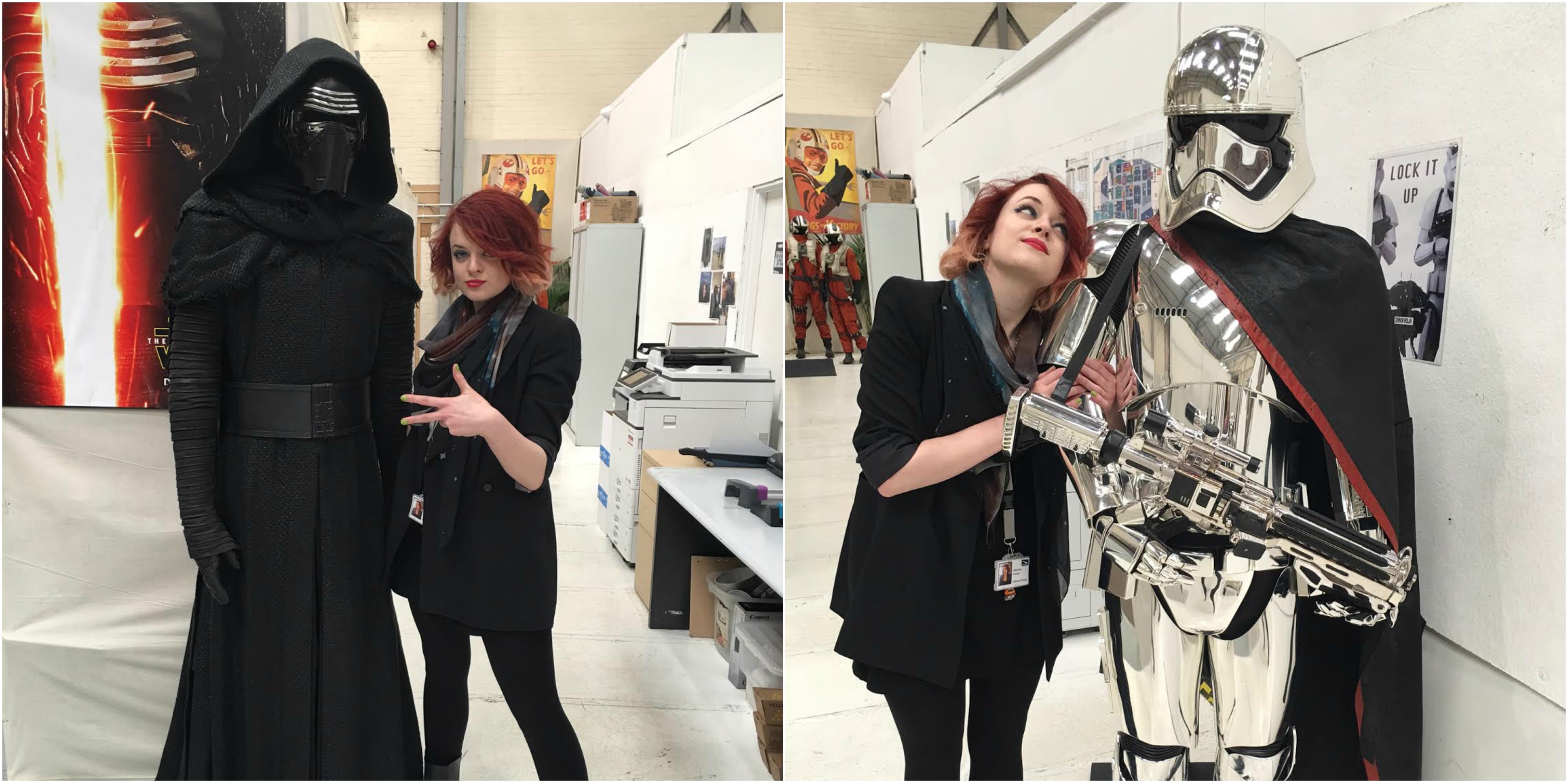
You worked on The Last Jedi as a Costume Buyer. How did you get this position and what does a Costume Buyer do on a film?
I got to work on The Last Jedi through hardwork and good timing. I had been working in the industry for several years and had started moving from mid-budget to larger budget films. When I discovered Rebels I was working on an extremely difficult production and I was extremely ill – discovering Rebels and The Clone Wars with it was what helped me get through each day. That job was awful for me, but a huge, huge learning curve that really pushed me. When I got to the end of production I thought it would be really funny if my rediscovered love of Star Wars led to a job on whatever project was happening next. So I shot off an email with my CV and went on holiday to Paris, and didn’t think anything more about it. When I came back I had an invitation to interview with Dave Crossman (the costume supervisor) based on my CV and, in particular, the difficult job I had just finished. Then I had another interview with Michael Kaplan, and then I had a start date and I was screaming internally. Just like that, I had gotten my childhood dream job, and I don’t think I’ll ever quite get over that. It was very surreal going into that space as a fan and knowing that is was where Star Wars was being made, so I tried really hard to hide how much of a fan I was and be cool.

The way I tend to put it is that a costume buyer is a facilitator. The designer’s job is to facilitate the director’s vision, my job is to facilitate the designer’s. On a production like Star Wars – where nearly everything is made in-house because there isn’t a handy Star Wars Shop. This means that I work with the design team, the makers and the wardrobe team. Makers to ensure that they have all their haberdashery, fabric, findings, and any other needs met. Likewise with the wardrobe team (ie. the on-set stand-by team), but for maintenance, comfort wear and so on. The majority of my work, though, is with the designer and the design assistants working from briefs to source fabrics, clothing, shoes… anything and everything. Somedays briefs are broad I will be looking for a ‘red wool’. Other days it will be an extremely specific silk jersey or a leather. Somedays it’s sourcing something like 1000m of aquarium tubing. If it is seen on screen, someone has sourced and bought that
How long were you were working on The Last Jedi as a costume buyer?
I was on The Last Jedi for a little under a year. Which for me, as a freelance costumier, is a long time!
What were some of the items you sourced for the film? Anything you want to share about certain things you were looking for? Anything that surprised you about this experience?
As a costume buyer it’s really hard to be able to point at the screen and say ‘I did that’. People always want to know what you made or what you designed, and it’s never as impressive when you say ‘Well, I found that fabric but there were only 4m left in the entire world, but I magically managed to source this perfect match,’ or ‘I found these amazing heavy duty invisible open-ended zips that revolutionised how we made that sleeve.’
A costume buyer is a very small cog in a very large machine, so it’s all a bit meaningless to anyone but me; the legs working hard under the water. Even within the department there can be a bit of unawareness of what the buyer is doing because we are rarely actually there in the office or workshop, we’re always out racing across the country sourcing and buying, hitting up our contacts to hopefully find that perfect something. We just show up at the start or end of the day with (hopefully) what is needed. The flipside of that is that it means that, technically speaking I had a (very small) hand in nearly every costume which is a very quiet satisfaction.
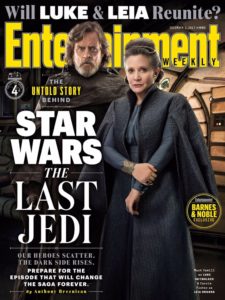
On a project like Star Wars the process was essentially the same as on any other production. Except that because it was Star Wars, everything was just so much more. There was this weight of responsibility on everything because you knew it meant so much, and it wasn’t just a film: it was a piece of cinematic history. So it could get a bit daunting when you’re out searching for the perfect fabric options for your childhood hero, Princess Leia. Or Luke Skywalker. Or you come back to the studio and there is Anthony Daniels as C3-PO being fitted. Or you’re sitting at your desk doing paperwork and turnaround and there is Darth Vader standing behind you. Or… a job like every other that just suddenly screeched to halt by these amazing, impossible moments.
One thing, actually, that I sourced and has had a weirdly huge impact on me was the space jewelry. I’m not always entirely sure what the final things being used on the cast: I source it, I pass it on, I move onto the next thing. Sometimes I’ll be there for fittings, but most of the time there is too much going on. So I vividly remember when I saw some of the magazine covers coming out ahead of The Last Jedi and I was suddenly overwhelmed because there was Holdo wearing the cuffs that I sourced. Then my heart stopped as I scrolled and there was Leia herself in the wave cuff that I had bought. Leia! Nevermind everything else that they were wearing, for some reason the fact that I had bought those specific elements incidentally – pieces that people were being moved and excited by and were writing think pieces on – meant everything to me. More than I could say. It really cemented for me that I had actually contributed to cinematic history, that my work has mattered to someone somewhere.
Can you say anything about projects you have coming up? Long-term are you hoping to be a costume designer for TV and films?
A few projects that I worked on are coming up soon: Duncan Jones’ Mute is getting released on Netflix in a few weeks, which was a really fun job for me as a buyer, then Tomb Raider is looming imminently. I also worked on Darkest Hour which I think is still showing since it got the Oscar nomination! It is always exciting to be a part of something that has been recognised in that way.
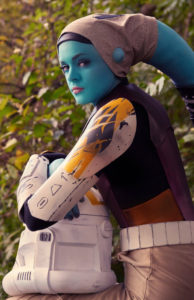
Long-term, I’m not really sure what my plan for the future is. Right now alongside my buying work I’m doing my Masters in Fashion Cultures at London College of Fashion, and taking the time to really dig into what I love about costume and fashion and how and why they can communicate so much to us – and how. It’s a real luxury to be able to take time to pause and take a hard, reflective look at what I do and what I love. My thesis will be on the concept of rebellion in Star Wars costuming, and how that has shifted yet remained consistent in significance over forty years. Costume is, I think, something that is widely misunderstood and underestimated. Often because it is just on screen doing its job, not distracting from the action. Screen costume academia is a relatively small field right now so I would like to be able to share how costume works both literally in its conception but also in its performance. Otherwise, my heart and soul is in costume and in film, and I know that so long as I am in some way contributing to bring stories and characters to life I will be happy. Designing for screen will always be a dream.
Finally, what is the most common misconception about being a cosplayer and a costume buyer (or perhaps the biggest misconception about the costume department in films)?
Historically the costume department has been one of the least regarded departments. To paraphrase Bridget Jones, a lot of people think that we fanny around with bits of fabric all day. I do think that this is something that is slowly shifting, and more respect is growing: I can’t count the number of times I’ve heard ‘I could never do your job/I could never work in costume!’ once they realise just how much is going on behind the scenes. Costume is so crucial to film and television. If it’s wrong then it fights the story and the narrative and can disrupt everything, both by distracting the audience but also by throwing off the actors and blocking their engagement with their characters. I have seen actors get utterly spooked and begin to consider backing out of a project based solely on how the costumes weren’t working. You always hear about actors saying that they find the character when they put on their costume and it sounds like so much actors process whatever, but I’ve seen it happen. That moment where suddenly everything slots into place and this character is standing there in the fitting room. Costume is just so crucial.
There is also a lack of respect – or acknowledgement, I guess – for contemporary projects. They have current fashions, that’s easy, right? Just nip out to the high street and grab some clothes. But it’s just as much work as a huge made production like Star Wars, and they come with their own set of challenges. Everything needs to look effortless but still be right. If a character is wearing jeans a t-shirt the designer is limited on what can be communicated with so little, so every tiny detail must be meticulously considered.
If young girls are reading this and want advice on breaking into the costume industry what advice would you give them?
There are so many different ways to get into costume, it is really hard to give specific recommendations. I did my degree in costume, posted hardcopies of my CV with cover letters to as many productions that I knew were going on as possible. It was very analogue, but because I had a still from a short film that I designed at university on my business cards, I caught the eye of the costume supervisor who eventually jumpstarted my career. You can do similar by researching productions online, or calling round the studios and asking to talk to production offices to get email addresses. It’s an introverts nightmare, it can take a long time to get your foot in the door, and even once you have that foot in it can take a while for work to become regular. Persistence is key. Passion is key. It sounds cheesy, but you need the passion for costume to drive you when it is 5am and you are standing in a horsebox in the middle of a muddy field desperately ironing dozens of shirts! Glamorous it is not.
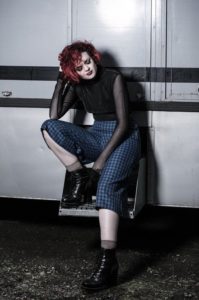
Work hard, be adaptable and flexible. A degree or formal education in costume, fashion, textiles or design is not necessary: find the path that works for you, but I do recommend knowing how to sew, even if it is just the fundamentals (it is a good life skill, too)! You would be surprised how many people in industry don’t know, and being able to hop in at an emergency moment with a needle and thread will get you far. Having as many skills as possible is always incredibly useful and will help people remember you – building a good reputation via word of mouth is key to getting by. However, don’t let yourself be taken advantage off. The costume is hard, physical work with long hours and it is very easy to destroy yourself. I got diagnosed with MES/Chronic Fatigue nearly five years ago because I didn’t set boundaries for my well-being and I worked and worked, and now I have permanently and irrevocably ruined my health and will always need to balance that.
I am biased, but I do recommend that everyone tries a go at buying. It’s difficult work, but it is a crash course in materials, construction and design as you are supporting every aspect of the department. I have been working predominantly as a buyer for around 4 years now, and I am constantly learning so much on every job.
You can find Alexina on Twitter @xenadd, on Instagram (poetryincostume), or on her website Poetry in Costume.
Check out the entire list of women in 365 Days of Star Wars Women in the Women in Star Wars Index. It includes highlights from each post plus notes which posts include new 365 interviews with actresses, writers, artists, and more.


